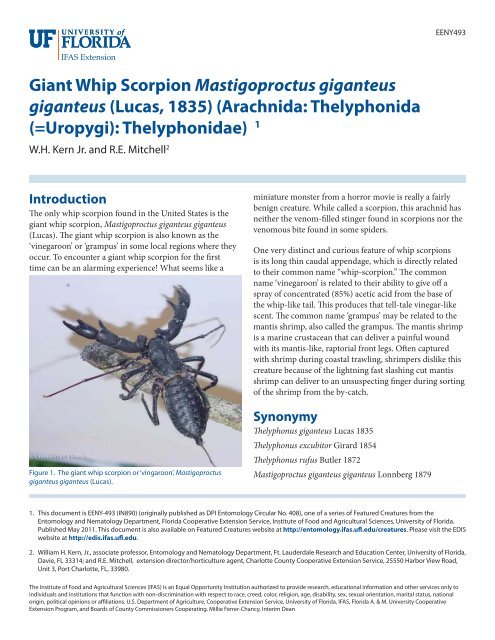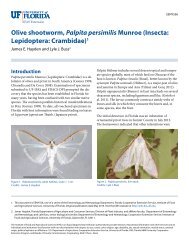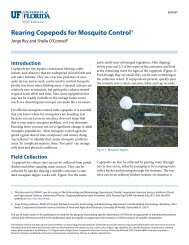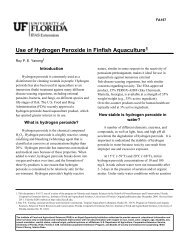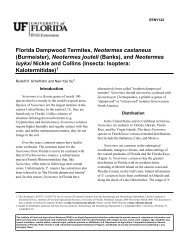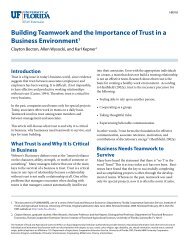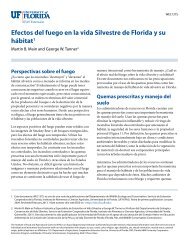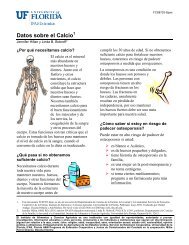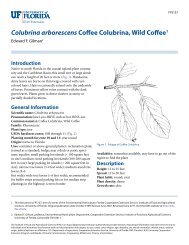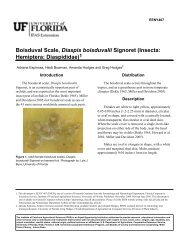Giant Whip Scorpion Mastigoproctus giganteus giganteus - EDIS ...
Giant Whip Scorpion Mastigoproctus giganteus giganteus - EDIS ...
Giant Whip Scorpion Mastigoproctus giganteus giganteus - EDIS ...
Create successful ePaper yourself
Turn your PDF publications into a flip-book with our unique Google optimized e-Paper software.
<strong>Giant</strong> <strong>Whip</strong> <strong>Scorpion</strong> <strong>Mastigoproctus</strong> <strong>giganteus</strong><br />
<strong>giganteus</strong> (Lucas, 1835) (Arachnida: Thelyphonida<br />
(=Uropygi): Thelyphonidae) 1<br />
W.H. Kern Jr. and R.E. Mitchell 2<br />
Introduction<br />
Th e only whip scorpion found in the United States is the<br />
giant whip scorpion, <strong>Mastigoproctus</strong> <strong>giganteus</strong> <strong>giganteus</strong><br />
(Lucas). Th e giant whip scorpion is also known as the<br />
‘vinegaroon’ or ‘grampus’ in some local regions where they<br />
occur. To encounter a giant whip scorpion for the fi rst<br />
time can be an alarming experience! What seems like a<br />
Figure 1. The giant whip scorpion or ‘vingaroon’, <strong>Mastigoproctus</strong><br />
<strong>giganteus</strong> <strong>giganteus</strong> (Lucas).<br />
EENY493<br />
miniature monster from a horror movie is really a fairly<br />
benign creature. While called a scorpion, this arachnid has<br />
neither the venom-fi lled stinger found in scorpions nor the<br />
venomous bite found in some spiders.<br />
One very distinct and curious feature of whip scorpions<br />
is its long thin caudal appendage, which is directly related<br />
to their common name “whip-scorpion.” Th e common<br />
name ‘vinegaroon’ is related to their ability to give off a<br />
spray of concentrated (85%) acetic acid from the base of<br />
the whip-like tail. Th is produces that tell-tale vinegar-like<br />
scent. Th e common name ‘grampus’ may be related to the<br />
mantis shrimp, also called the grampus. Th e mantis shrimp<br />
is a marine crustacean that can deliver a painful wound<br />
with its mantis-like, raptorial front legs. Oft en captured<br />
with shrimp during coastal trawling, shrimpers dislike this<br />
creature because of the lightning fast slashing cut mantis<br />
shrimp can deliver to an unsuspecting fi nger during sorting<br />
of the shrimp from the by-catch.<br />
Synonymy<br />
Th elyphonus <strong>giganteus</strong> Lucas 1835<br />
Th elyphonus excubitor Girard 1854<br />
Th elyphonus rufus Butler 1872<br />
<strong>Mastigoproctus</strong> <strong>giganteus</strong> <strong>giganteus</strong> Lonnberg 1879<br />
1. This document is EENY-493 (IN890) (originally published as DPI Entomology Circular No. 408), one of a series of Featured Creatures from the<br />
Entomology and Nematology Department, Florida Cooperative Extension Service, Institute of Food and Agricultural Sciences, University of Florida.<br />
Published May 2011. This document is also available on Featured Creatures website at http://entomology.ifas.ufl .edu/creatures. Please visit the <strong>EDIS</strong><br />
website at http://edis.ifas.ufl .edu.<br />
2. William H. Kern, Jr., associate professor, Entomology and Nematology Department, Ft. Lauderdale Research and Education Center, University of Florida,<br />
Davie, FL 33314; and R.E. Mitchell, extension director/horticulture agent, Charlotte County Cooperative Extension Service, 25550 Harbor View Road,<br />
Unit 3, Port Charlotte, FL, 33980.<br />
The Institute of Food and Agricultural Sciences (IFAS) is an Equal Opportunity Institution authorized to provide research, educational information and other services only to<br />
individuals and institutions that function with non-discrimination with respect to race, creed, color, religion, age, disability, sex, sexual orientation, marital status, national<br />
origin, political opinions or affi liations. U.S. Department of Agriculture, Cooperative Extension Service, University of Florida, IFAS, Florida A. & M. University Cooperative<br />
Extension Program, and Boards of County Commissioners Cooperating. Millie Ferrer-Chancy, Interim Dean
Distribution<br />
<strong>Mastigoproctus</strong> <strong>giganteus</strong> <strong>giganteus</strong> is the only whip<br />
scorpion found in the United States. Th is subspecies occurs<br />
in Arizona, Florida, New Mexico, Oklahoma, Texas, and<br />
in Mexico. Two other subspecies, <strong>Mastigoproctus</strong> <strong>giganteus</strong><br />
mexicanus (Lucas 1835) and <strong>Mastigoproctus</strong> <strong>giganteus</strong><br />
scabrosus (Lucas 1835) are confi ned to portions of Mexico.<br />
As a group, whip scorpions are found worldwide in the<br />
tropics and subtropics. While more commonly encountered<br />
in arid areas, <strong>Mastigoproctus</strong> <strong>giganteus</strong> can also be found in<br />
grassland, scrub, pine forests and barrier islands.<br />
Table 1. Other species in the genus <strong>Mastigoproctus</strong> and their general distribution in the Americas.<br />
Species Name General Distribution<br />
M. baracoensis Cuba<br />
M. brasiliensis Brazil (Espirito Santo)<br />
M. butleri Brazil<br />
M. columbianus Colombia<br />
M. formidabilis Venezuela<br />
M. liochirus Guatemala<br />
M. maximus Brazil (Mato Grosso)<br />
M. minensis Brazil (Minas Gerais)<br />
M. nana Costa Rica<br />
M. pelegrini Cuba<br />
M. perditus Brazil (Mato Grosso)<br />
M. proscorpio Hispaniola, Martinique<br />
M. tantalus El Salvador<br />
Description<br />
Th is is a fairly large creature, up to 5 cm long, which does<br />
not include the caudal fl agellum or telson. Large pedipalps<br />
(pincer-like appendages) help whip scorpions catch and kill<br />
their prey by crushing them. Mishandled, these pedipalps<br />
can give a noticeable pinch. A pair of long, thin front legs<br />
acts almost like antennae as they feel about for their prey in<br />
the dark. Th e whip-like telson also functions as a sensory<br />
organ. Th ese three structures apparently help compensate<br />
for their eight weak eyes.<br />
Table 2. Measurements of 10 representative females and one male <strong>Mastigoproctus</strong> <strong>giganteus</strong> <strong>giganteus</strong> (Muma 1968). The telson or<br />
caudal fl agellum was extremely variable due to breakage, but some had a telson longer than the total body length.<br />
Females (10) Total<br />
Lengths in mm<br />
Carapace of<br />
Cephalothorax<br />
Abdomen<br />
Max 50.0 21.0 30.0<br />
Min 38.0 11.0 24.0<br />
Mean 45.3 18.5 27.9<br />
Male (1)<br />
45.0 18.0 27.0<br />
Table 3. Measurements of 3 Riker mount specimens of <strong>Mastigoproctus</strong> <strong>giganteus</strong> <strong>giganteus</strong> by this author.<br />
Lengths in mm<br />
N= 3 Total Carapace of<br />
Cephalothorax<br />
Abdomen Telson<br />
Max 44.0 18.0 25.0 40.0<br />
Min 37.0 14.0 21.0 32.0<br />
2
Figure 2. Dorsal view and anatomical features of the giant whip<br />
scorpion or ‘vingaroon’, <strong>Mastigoproctus</strong> <strong>giganteus</strong> <strong>giganteus</strong> (Lucas).<br />
Figure 3. Ventral view of the giant whip scorpion or ‘vingaroon’,<br />
<strong>Mastigoproctus</strong> <strong>giganteus</strong> <strong>giganteus</strong> (Lucas).<br />
Figure 4. Close-up view of the prosoma (cephalothorax) of the giant<br />
whip scorpion or ‘vingaroon’, <strong>Mastigoproctus</strong> <strong>giganteus</strong> <strong>giganteus</strong><br />
(Lucas).<br />
Life History and Habitat<br />
<strong>Whip</strong> scorpions are nocturnal predators of other<br />
arthropods. During the day they remain out of sight in<br />
burrows they dig with their pedipalps. Th ey can oft en be<br />
found under logs, boards, rotting wood, rocks, and other<br />
natural dark places. Most whip scorpions occur in moist or<br />
seasonally moist forested habitats in tropical or subtropical<br />
environments. <strong>Mastigoproctus</strong> <strong>giganteus</strong> occur in more<br />
arid habitats with well drained soil. Th ey spend the driest<br />
periods underground and become active on the surface<br />
during Florida’s rainy season (May/June-November).<br />
Th e primary prey of <strong>Mastigoproctus</strong> <strong>giganteus</strong> are soft bodied<br />
insects like termites, cockroaches, and crickets. One of<br />
the common prey of adults in Florida is the Florida woods<br />
roach, Eurycotis fl oridensis. Live food such as crickets and<br />
roaches are crushed between special teeth on the inside of<br />
the second segment of the pedipalps.<br />
When threatened, vinegaroons seek the refuge of their<br />
burrows or put on a bluff display of rearing up and spreading<br />
their pedipalps. Th ey can also accurately spray acetic<br />
3
acid from a pore at the base of the caudal fi lament to a<br />
distance of a few inches to one foot. Th is defensive spray is<br />
not dangerous to skin but stings severely if it gets into an<br />
animal’s eyes or nostrils.<br />
Figure 5. The giant whip scorpion or ‘vingaroon’, <strong>Mastigoproctus</strong><br />
<strong>giganteus</strong> <strong>giganteus</strong> (Lucas), displaying defensive stance with spread<br />
pedipalps.<br />
Fairly long-lived, whip scorpions can live at least seven<br />
years. Th ey grow slowly, molting three times in about three<br />
years. Once becoming adults, they live up to another four<br />
years.<br />
Mating takes place in the fall. A complex mating ritual<br />
lasts eight to 12 hours. Th e male secretes and transfers a<br />
sperm sac (spermatophore) into the female. She carries<br />
the eggs internally for several months and then lays 30 to<br />
40 eggs in a fl uid fi lled sac held under her abdomen. She<br />
remains in her burrow holding the egg sac off the ground<br />
for an additional two months. Th e mucous membrane helps<br />
preserve moisture, allowing the eggs to develop. Th e young<br />
are white in color when they hatch from the eggs and then<br />
climb onto their mother’s back for about one month. Once<br />
the fi rst molt is complete the second instar young look<br />
like miniatures of the adults. At this point, they leave their<br />
mother’s burrow. Th e mother whip scorpion, completing<br />
her life cycle, dies soon aft er. Immature <strong>Mastigoproctus</strong><br />
<strong>giganteus</strong> take a year between each of the next three molts.<br />
Natural Enemies<br />
<strong>Mastigoproctus</strong> <strong>giganteus</strong> is large enough to be a reasonable<br />
meal for mammals like raccoons, coatis, armadillos, skunks,<br />
and even bear, feral hogs and peccaries.<br />
Selected References<br />
• BugGuide. (September 2009). Species <strong>Mastigoproctus</strong><br />
<strong>giganteus</strong> - <strong>Giant</strong> Vinegaroon. http://bugguide.net/node/<br />
view/29752 (21 OCtober 2010).<br />
• Drees BM, Jackman J. (1999). Vinegaroon. A Field<br />
Guide to Common Texas Insects. http://insects.tamu.edu/<br />
fi eldguide/cimg365.html (21 October 2010).<br />
• Fox R. (June 2006). Th elyphonus © - <strong>Whip</strong> <strong>Scorpion</strong>.<br />
Invertebrate Anatomy OnLine. http://webs.lander.edu/<br />
rsfox/invertebrates/thelyphonus.html (21 October 2010).<br />
• Harvey MS. 2003. Catalogue of the Smaller Arachnid<br />
Orders of the World: Amblypygi, Uropygi, Schizomida,<br />
Palpigradi, Ricinulei and Solifugae. CSIRO Publishing.<br />
400 pp.<br />
• McMonigle O. 2008. <strong>Whip</strong>scorpions and <strong>Whip</strong>spiders:<br />
Culturing Gentle Monsters. Elytra & Antenna Publishing.<br />
40 pp.<br />
• Muma MH. 1967. Arthropods of Florida and Neighboring<br />
Land Areas Volume 4; <strong>Scorpion</strong>s, <strong>Whip</strong> <strong>Scorpion</strong>s<br />
and Wind <strong>Scorpion</strong>s of Florida. Florida Department of<br />
Agriculture and Consumer Services, Division of Plant<br />
Industries, Gainesville, FL. 28 pp.<br />
4


